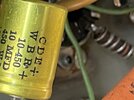Playing with an old Maverick 250 amp and coming up at a loss with my semi-limited electronic knowledge with a problem on the 10 meter setting. For what I know of this unit the last time it was used the choke on the top had cooked and the unit was shelved after it was replaced. Tubes seemed shot but were not tested on removal. Put in a full set of tested and strong tubes. fired it up. Radio is a 10 meter radio (anytone Q6) and set at about 1/3rd power. I do get transmit and reduced output on the 15 meter setting and close to 400 watts. When I drop to 10 nothing. The key circuit is engaging and disengaging as normal and by all accounts everything looks like it should be running but there is no amp output at all. All other knobs, switches, meters and such operate normally.
A second matching amp I have here reacts identically on the 15 meter band so it appears the amplifier portion is working fine along with the tubes.
I can replace many parts in these things. I sadly have little knowledge in trying to diagnose something without a burnt part or obvious failure. Any suggestions welcome!
A second matching amp I have here reacts identically on the 15 meter band so it appears the amplifier portion is working fine along with the tubes.
I can replace many parts in these things. I sadly have little knowledge in trying to diagnose something without a burnt part or obvious failure. Any suggestions welcome!


